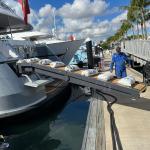8 Steps to Maritime Cybersecurity Excellence: Mastering IT Audits with IACS E26 and E27 Standards
1. Preparation and Planning
a. Understand the Standards:
- Familiarize yourself with the IACS E26 and E27 standards to understand the requirements and guidelines for cybersecurity in maritime operations.
b. Define Scope and Objectives:
- Determine the scope of the audit, including which systems, networks, and processes will be reviewed.
- Set clear objectives for what you aim to achieve with the audit, such as identifying vulnerabilities, ensuring compliance, or improving security measures.
c. Assemble the Audit Team:
- Gather a team of qualified auditors with expertise in maritime cybersecurity, IT systems, and the specific requirements of IACS E26 and E27.
d. Gather Documentation:
- Collect relevant documentation, including security policies, network diagrams, system configurations, access control lists, and incident response plans.
2. Risk Assessment
a. Identify Critical Assets:
- List all critical assets, such as navigation systems, communication systems, and other essential IT infrastructure on the vessel.
b. Assess Threats and Vulnerabilities:
- Identify potential threats (e.g., cyber-attacks, insider threats) and vulnerabilities (e.g., outdated software, weak passwords) that could impact the vessel's cybersecurity.
c. Evaluate Risk Levels:
- Assess the likelihood and potential impact of each identified threat and vulnerability to prioritize areas for further investigation and mitigation.
3. Review of Access Controls
a. Verify Authentication Mechanisms:
- Check the effectiveness of authentication mechanisms, such as passwords and multi-factor authentication, to ensure they are robust and properly implemented.
b. Evaluate Authorization Processes:
- Review how access rights and permissions are granted, managed, and revoked to ensure they follow the principle of least privilege.
c. Monitor Access Logs:
- Analyze access logs to detect any unusual or unauthorized access attempts and ensure that logging mechanisms are in place and functioning correctly.
4. Network Security Assessment
a. Review Network Architecture:
- Examine the network design to ensure it includes segmentation, firewalls, and intrusion detection/prevention systems as recommended by IACS standards.
b. Conduct Vulnerability Scanning:
- Perform regular vulnerability scans to identify and address security weaknesses in the network.
c. Test Network Security Controls:
- Validate the effectiveness of security controls, such as encryption, VPNs, and secure communication protocols.
5. Software and System Security
a. Check for Updates and Patches:
- Ensure that all software, firmware, and operating systems are up-to-date with the latest security patches.
b. Review Configuration Management:
- Verify that systems are configured securely according to best practices and IACS guidelines.
c. Perform Malware Detection:
- Use antivirus and anti-malware tools to scan systems for malicious software and ensure these tools are regularly updated.
6. Incident Response and Recovery
a. Evaluate Incident Response Plans:
- Review the vessel's incident response plan to ensure it is comprehensive, up-to-date, and aligned with IACS standards.
b. Test Incident Response Procedures:
- Conduct simulations and drills to test the effectiveness of the incident response plan and the crew's readiness to handle cyber incidents.
c. Assess Backup and Recovery Processes:
- Ensure that backup procedures are in place and regularly tested to facilitate quick recovery in the event of a cyber incident.
7. Compliance and Documentation
a. Verify Compliance:
- Ensure that all cybersecurity practices and measures comply with IACS E26 and E27 standards and other relevant regulations.
b. Document Findings:
- Record all findings, including identified vulnerabilities, areas of non-compliance, and recommended improvements.
c. Provide Recommendations:
- Offer actionable recommendations to address identified issues and enhance the vessel's cybersecurity posture.
8. Reporting and Follow-Up
a. Compile an Audit Report:
- Prepare a detailed audit report summarizing the findings, recommendations, and any corrective actions taken.
b. Present Findings to Stakeholders:
- Share the audit report with relevant stakeholders, including vessel owners, operators, and IT personnel.
c. Monitor Implementation:
- Follow up on the implementation of recommendations and corrective actions to ensure they are effectively addressing the identified issues.
d. Schedule Regular Audits:
- Plan for regular cybersecurity audits to maintain ongoing compliance with IACS E26 and E27 standards and continuously improve the vessel’s cybersecurity defenses.
By following these steps, you can ensure a thorough and effective IT audit that aligns with the IACS E26 and E27 standards, helping to protect your vessel's critical systems and data from cyber threats.




